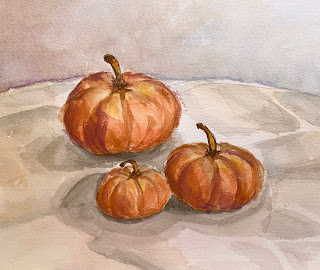The people you paint with will influence your work and your attitudes toward success.
| Channel Marker, 9X12, Carol L. Douglas, available. |
If you’ve ever felt the powerful need to adjust your thinking to fit in, it’s not just moral weakness. We’re designed as herd animals, and that need to conform is built into us on a neural level. Disagreeing with our friends and neighbors makes us physically, emotionally and mentally uncomfortable.
Social norms are the rules that govern our group behavior, and they’re important. They’re how we all agree to forgo self-serving behaviors for the good of the group. These social norms—more so even than the force of law—govern our society.
 |
| Fog Bank, 14X18, Carol L. Douglas, available. |
Some social norms (“thou shalt not kill”) are static, but others are fluid; for example, we’ve decided over the last three hundred years that child labor is morally wrong.
Group norming affects artists as much as anyone. We tend to slip into painting like our friends and neighbors. That’s why we develop painting schools like the Group of Seven. Artists working together subtly create a stylistic group norm.
This was demonstrated to me over the past weeks as we studied composition. There are rules we accept today that wouldn’t have occurred to a Manneristpainter.
 |
| Midsummer, 24X36, Carol L. Douglas, available. |
Groupthink is aspirational, too. Successful thinking can be transmitted through a group as surely as clothing choices can.
I’ve just finished a year-long session with two very successful groups of students. Mary Silver found representation in a gallery in downtown San Antonio. Patty Mabie won “best floral” in the April Plein Air salon. Lori Capron Galan was juried into the Rochester Art Club. Several sold paintings over the past few months. All painted consistently to a high level. They created a culture of success, and that has pushed all of them to a high level of performance.
There are times when artists feel very alone. I felt stylistically isolated in western New York because my own painting was based on different norms. That went away when I moved to coastal Maine. Coastal Maine is inherently no better than western New York, but my own painting ethos was there, rather than in the Hudson River School.
| Sometimes it rains, 8X10, Carol L. Douglas, available. |
This points to the conundrum of the artist’s way, which is two-fold. Our work is communication, but it must be done very much alone. Moreover, we are part of a social continuum, but we strive to say something unique.
In the end, that’s the definition of leadership. That has nothing to do with seniority, titles, wealth, or management. It’s a process of social influence, and it’s a great responsibility.






